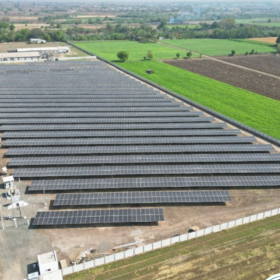It could have been the plot to a great Bollywood movie: India’s solar market emerges from the fog, flexes its muscles and rides off into the sunset. Cue the dancing. Such a screenplay, while engaging, would quickly have been taken to task for its many plot holes. In the real world, India’s solar market – despite its growing popularity – is eyeing brighter days ahead with a growing sense of trepidation, and the background actors are looking on nervously. This includes several solar associations, customs bodies, and even the national government itself. Many would-be actors in this great Indian drama have shied away from the spotlight, or are hanging around in the background angling for a starring role.
At present, several import duties are hovering ominously over the Indian solar sector. Namely, safeguard duty, import duty, a proposed anti-dumping duty, and – in addition to this – the goods and service tax (GST), which became applicable to solar in 2017, are all forming part of a potentially damaging cocktail.
Each proposed duty or tariff has its own objective. The safeguard duty is a product-specific duty, and is imposed when good have entered in increased quantities into the domestic market, or if those goods can cause or threaten to cause serious injury to local producers of similar or directly competitive products. Unlike other tariffs, the safeguard duty is origin-agnostic, and applies to all such offending products regardless of which country they came from.
The import duty is also known as the Basic Customs Duty (BCD), and is levied on any goods that are imported into the country unless the Union Government notifies explicitly that a product is to be exempt. This duty can vary between 5% to 40%, depending upon the type of goods.
And finally, an anti-dumping duty (ADD) is – as most solar observers are only too aware – a duty that is imposed on a product originating from a specific country. It is taxed only if said country is exporting said goods at dumped prices, and if the dumped imports cause, or threaten to cause, material injury or material manipulation of the establishment or survival of the relevant domestic industry.
In a recent domestic content dispute with the U.S., a World Trade Organisation (WTO) official told pv magazine that the case is now going to arbitration. The details of that dispute center on how the U.S. has failed to defend its argument to the dispute settlement body; something that has seen India receive support from many other countries. India stressed in the dispute that it has already obeyed the domestic content regulation and has released a statement regarding the use of open source materials in solar projects.
Why are duties required?
India’s Director General of Safeguards, Customs, and Central Excise (DGSCCE) submitted a document to the nation’s finance ministry on January 5, defending the Indian Solar Manufacturers Association (ISMA) case. The document stated that solar imports are creating serious injury to the country’s domestic manufacturing sector. The ISMA filed the petition last December on behalf of five companies, including Mundra Solar PV Ltd, Indosolar Ltd, Jupiter Solar Power Ltd, Websol Energy Systems Ltd, and Helios PV Ltd.
According to the DGSCCE document, India’s share of Chinese solar imports globally increased from 1.52% in 2012 to 21.58% in 2016, in contrast to the cumulative share of the EU and the U.S. solar markets, which collectively reduced from 75.93% in 2012 to 23.42% in 2016.
According to the DGSCCE, over the last three years, India has increased its imports from 18.51% in the first half (H1) of 2016 to 38.77% in H1 2017. In contrast, China’s exports to the EU and the U.S. combined reduced from 30.65% in H1 2016 to just 5% in H1 2017.
Another significant finding is the price deviation, which has severely damaged the domestic industry’s growth. As of September 2017, the average module price for imported modules was INR 24.77 ($0.39)/W, while domestic modules are priced at INR 92 ($1.44)/W.
Looking at the data, it would appear that higher domestic prices are one of the main reasons for the increase in imports from China. India increased its domestic solar module production from 246 MW in 2014-15 to 1,164 MW in 2017-18. Despite that growth, the market share of the domestic industry decreased from 13% in 2014-15 to 7% during 2017-18. During the same period, the market share of imports increased from 86% to 90%.
On account of this, many domestic producers have kept their production facilities almost idle, and their heavy losses have served to further cripple the domestic industry’s ability to respond to market demand. At the end of 2017, capacity utilization stood at just 53%, down from 78% in 2016-17. This, in turn, has had an impact on the decline in employment growth, and a sharp decline in productivity per employee.
Proposed taxes
The DGSCCE has proposed to impose a 70% safeguard duty for a period of 200 days. A high figure, for a relatively short period of time. So what comes after the 200-day period has elapsed? HR Gupta, General Secretary, ISMA, addressed this question in an interview with pv magazine, confirming: “200 days is just a period of investigation. The tax period would be for three to four years.” Moreover, he mentioned that the 70% duty is proposed by the Director General complying with the WTO guidelines. According to the market, this number is quite high and should be reduced. Moreover, the ISMA also does not know how much tax will be levied.
In addition, the government is also planning to impose a 7.5% import duty on imported cells and modules. Last year in September, Chennai port already levied this tax, and began defining the modules as a motor, ie, as falling under the same category as other motors that generate power. Solar developers, however, made a series of complaints against this classification, and now the case is up in front of the courts, Gupta confirmed.
The idea of imposing a 7.5% import duty on to solar panels by classifying them as motors would, rather ironically, contradict and undermine the entire logic underpinning the safeguard duty. The ISMA sought to bring clarity to such speculation, with Gupta adding: “I do not see any challenge because looking at the product and the consideration (stated in a report filed by the Directorate General), it mentioned clearly that the solar cells are the main item, whether or not they are assembled into panels.”
In the case of ADD, no concrete figures have yet emerged as to the level of the tariff, and few industry experts are willing to stick their neck out and hazard a guess at the potential percentage of duties that could be imposed. Additionally, the GST ranges between 5-18% on various input costs. Together, these proposed, mooted and enacted taxes and tariffs serve to highlight the acute lack of coordination between government departments, and the absence of a standard policy.
Potential effects
As things stand right now, the hottest topic facing India’s solar sector is the safeguard duty. Indian solar stakeholders have heavily opposed the upcoming duty. The All India Solar Industries Association (AISIA) General Secretary, Gyanesh Choudhary, told pv magazine that the levy would have a detrimental effect on manufacturers operating out of the Special Economic Zones. Regarding import duty, he said: “A 7.5% import tax can lead to an increase in the cost of solar projects by 4.5%.”
Bridge to India, the Gurugram-based consultancy firm, also believes that the upcoming safeguard duty will derail a great number of solar projects. Mudit Jain, Senior Manager – Consulting, Bridge to India mused to pv magazine: “If the tax is just on cells, then the project cost will increase by 25%. Moreover, if it is levied on modules, then the project cost will increase by up to 40%.”
Orb Energy, a module manufacturer in Indian that also finances solar rooftop projects nationwide for small and medium enterprises that have difficulties in raising the necessary funds, has also been vocal about the potential impact of the safeguard duty. Orb Energy CEO, Damian Miller, told pv magazine that a 70% tax does not make any sense. “It will kill the market overnight if imposed,” he warned. “The average payback period for C&I rooftop projects is 3-4 years without any subsidy. However, the upcoming levy will increase it to 6-7 years, which is a huge setback.”
According to Bridge to India, a final duty of between 30-70% would imply that tariffs would need to go up by between 17-35%, or about INR 0.45-0.90/kWh, to maintain sensible financial returns. The consultancy firm also believes that the private market, both rooftop and open access solar, would be worst affected. It finds that this segment could see a 50% volume decline if a duty exceeding 20% is imposed.
 AISIA – ISMA
AISIA – ISMA
AISIA has actively opposed the proposed safeguard duty. Instead of imposing such measures across the board, the association has suggested that domestic manufacturers not be required to pay these taxes if the processing of raw materials takes place in SEZ. This, AISIA argues, will help to support the growth of local industry.
However, Jain does not believe that such suggestions will work, if such duties were to come, they will be imposed entirely and not in a piecemeal or selective manner. Bridge to India and many developers are afraid that such a duty would be counterproductive for the solar industry. However, ISMA has sought to allay such speculations.
Gupta explained that Indian solar developers have been bidding aggressively for the past five to six years following the reduction of module prices. The developers have made a profit out of it, and at that time nobody was worried about these relatively abnormal levels of profitability. However, since India’s domestic manufacturing sector is now on a path to the grave, such a duty is essential.
Gupta explained. “The expected derailing is part of a bumpy process. I guess there you have no choice; either absorb it to complete the project, or not. However, I do not think it will derail India’s solar mission; the developers just popularize that. Because whatever is committed, there will have to be some financial entitlement. However, there is no such derailment.” Gupta also said that suggestions from AISIA are valid and he makes it clear that the industry is largely all on the same page, working to save the domestic market.
Moreover, on behalf of AISIA, Choudhary also suggested that the differential anti-dumping duty should be applied, calling for a higher ADD on solar modules and a lower rate on solar cells because the production capacity of solar cells is currently too low.

Unwanted uncertainty
India’s solar sector is growing exponentially, expanding at a pace of 900% over the last three years, adding around 10 GW in 2017. The government has announced its ambitious roadmap for the next three financial years. India had already tendered 1.2 GW of PV projects in the very first week of January. However, the parallel inclusion of the import duties to support its domestic manufacturing sector is not a well-thought-through idea.
This whole scenario has created an uncertainty in the Indian solar market that very few will welcome. The main reason for this is the uncertainty regarding how much percentage of tax will be levied, and when it will be levied. Nobody in industry or authority has any clear idea. Because of this, solar developers’ plans are in purgatory; stuck between the uncertainty of whether to keep bidding or not, and in the dark over what will happen if the imposition arrives during a project’s commissioning stage.
Even if the duty is to be imposed, it is an immensely difficult task to set up a factory within the timeframe of a year in order to possess the capability to fulfill demand. Orb Energy’s Miller believes there should be no duty on cells and just a slight duty on modules, stressing that manufacturing solar cells is an energy-intensive industry rather than a job-intensive one. Miller also said that solar projects are creating jobs at a rate that would not be matched by the growth of the manufacturing sector.
Bridge to India thinks that such a duty may arrive in February. However, at the time of going to press, we can deal merely with speculation. As things stand, every stakeholder with a vested interest in the future of the Indian solar industry should aim to be a part of this debate while waiting for the final script and plot to come from the government.
This content is protected by copyright and may not be reused. If you want to cooperate with us and would like to reuse some of our content, please contact: editors@pv-magazine.com.








1 comment
By submitting this form you agree to pv magazine using your data for the purposes of publishing your comment.
Your personal data will only be disclosed or otherwise transmitted to third parties for the purposes of spam filtering or if this is necessary for technical maintenance of the website. Any other transfer to third parties will not take place unless this is justified on the basis of applicable data protection regulations or if pv magazine is legally obliged to do so.
You may revoke this consent at any time with effect for the future, in which case your personal data will be deleted immediately. Otherwise, your data will be deleted if pv magazine has processed your request or the purpose of data storage is fulfilled.
Further information on data privacy can be found in our Data Protection Policy.